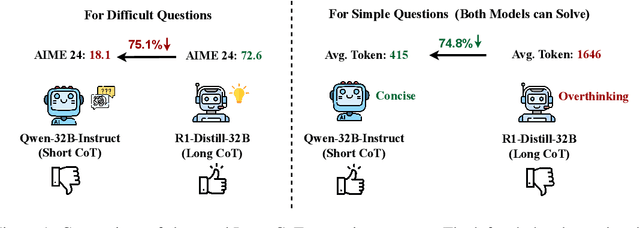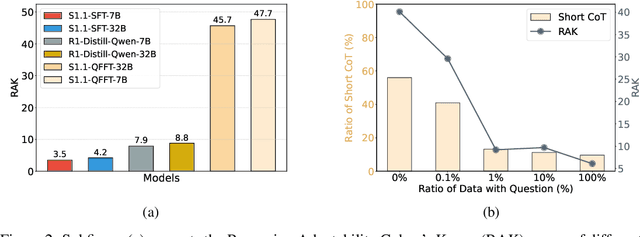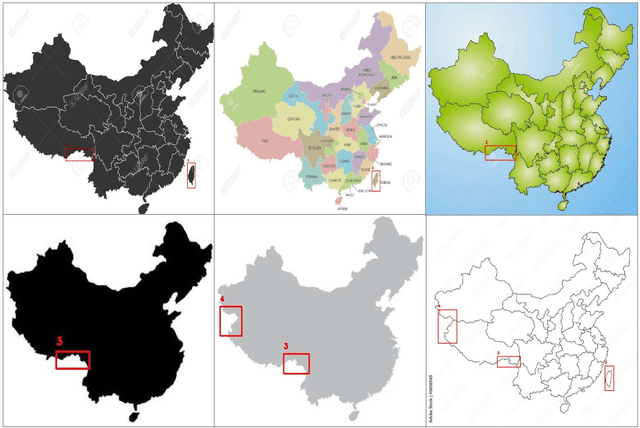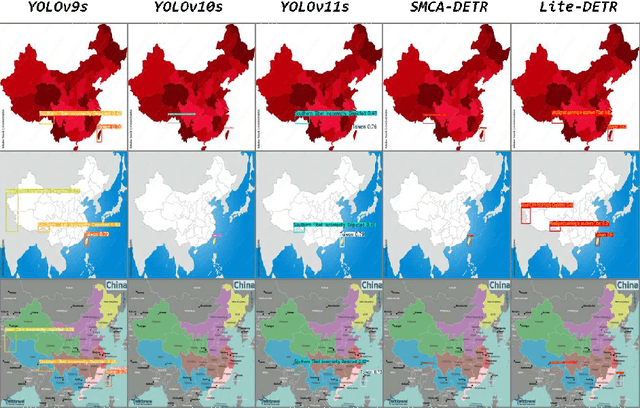Yan Xu
QFFT, Question-Free Fine-Tuning for Adaptive Reasoning
Jun 15, 2025



Abstract:Recent advancements in Long Chain-of-Thought (CoT) reasoning models have improved performance on complex tasks, but they suffer from overthinking, which generates redundant reasoning steps, especially for simple questions. This paper revisits the reasoning patterns of Long and Short CoT models, observing that the Short CoT patterns offer concise reasoning efficiently, while the Long CoT patterns excel in challenging scenarios where the Short CoT patterns struggle. To enable models to leverage both patterns, we propose Question-Free Fine-Tuning (QFFT), a fine-tuning approach that removes the input question during training and learns exclusively from Long CoT responses. This approach enables the model to adaptively employ both reasoning patterns: it prioritizes the Short CoT patterns and activates the Long CoT patterns only when necessary. Experiments on various mathematical datasets demonstrate that QFFT reduces average response length by more than 50\%, while achieving performance comparable to Supervised Fine-Tuning (SFT). Additionally, QFFT exhibits superior performance compared to SFT in noisy, out-of-domain, and low-resource scenarios.
Quantum Learning and Estimation for Distribution Networks and Energy Communities Coordination
Jun 13, 2025Abstract:Price signals from distribution networks (DNs) guide energy communities (ECs) to adjust energy usage, enabling effective coordination for reliable power system operation. However, this coordination faces significant challenges due to the limited availability of information (i.e., only the aggregated energy usage of ECs is available to DNs), and the high computational burden of accounting for uncertainties and the associated risks through numerous scenarios. To address these challenges, we propose a quantum learning and estimation approach to enhance coordination between DNs and ECs. Specifically, leveraging advanced quantum properties such as quantum superposition and entanglement, we develop a hybrid quantum temporal convolutional network-long short-term memory (Q-TCN-LSTM) model to establish an end-to-end mapping between ECs' responses and the price incentives from DNs. Moreover, we develop a quantum estimation method based on quantum amplitude estimation (QAE) and two phase-rotation circuits to significantly accelerate the optimization process under numerous uncertainty scenarios. Numerical experiments demonstrate that, compared to classical neural networks, the proposed Q-TCN-LSTM model improves the mapping accuracy by 69.2% while reducing the model size by 99.75% and the computation time by 93.9%. Compared to classical Monte Carlo simulation, QAE achieves comparable accuracy with a dramatic reduction in computational time (up to 99.99%) and requires significantly fewer computational resources.
Safe: Enhancing Mathematical Reasoning in Large Language Models via Retrospective Step-aware Formal Verification
Jun 05, 2025Abstract:Chain-of-Thought (CoT) prompting has become the de facto method to elicit reasoning capabilities from large language models (LLMs). However, to mitigate hallucinations in CoT that are notoriously difficult to detect, current methods such as process reward models (PRMs) or self-consistency operate as opaque boxes and do not provide checkable evidence for their judgments, possibly limiting their effectiveness. To address this issue, we draw inspiration from the idea that "the gold standard for supporting a mathematical claim is to provide a proof". We propose a retrospective, step-aware formal verification framework $Safe$. Rather than assigning arbitrary scores, we strive to articulate mathematical claims in formal mathematical language Lean 4 at each reasoning step and provide formal proofs to identify hallucinations. We evaluate our framework $Safe$ across multiple language models and various mathematical datasets, demonstrating a significant performance improvement while offering interpretable and verifiable evidence. We also propose $FormalStep$ as a benchmark for step correctness theorem proving with $30,809$ formal statements. To the best of our knowledge, our work represents the first endeavor to utilize formal mathematical language Lean 4 for verifying natural language content generated by LLMs, aligning with the reason why formal mathematical languages were created in the first place: to provide a robust foundation for hallucination-prone human-written proofs.
FEAT: Full-Dimensional Efficient Attention Transformer for Medical Video Generation
Jun 05, 2025Abstract:Synthesizing high-quality dynamic medical videos remains a significant challenge due to the need for modeling both spatial consistency and temporal dynamics. Existing Transformer-based approaches face critical limitations, including insufficient channel interactions, high computational complexity from self-attention, and coarse denoising guidance from timestep embeddings when handling varying noise levels. In this work, we propose FEAT, a full-dimensional efficient attention Transformer, which addresses these issues through three key innovations: (1) a unified paradigm with sequential spatial-temporal-channel attention mechanisms to capture global dependencies across all dimensions, (2) a linear-complexity design for attention mechanisms in each dimension, utilizing weighted key-value attention and global channel attention, and (3) a residual value guidance module that provides fine-grained pixel-level guidance to adapt to different noise levels. We evaluate FEAT on standard benchmarks and downstream tasks, demonstrating that FEAT-S, with only 23\% of the parameters of the state-of-the-art model Endora, achieves comparable or even superior performance. Furthermore, FEAT-L surpasses all comparison methods across multiple datasets, showcasing both superior effectiveness and scalability. Code is available at https://github.com/Yaziwel/FEAT.
Pangu Ultra MoE: How to Train Your Big MoE on Ascend NPUs
May 07, 2025Abstract:Sparse large language models (LLMs) with Mixture of Experts (MoE) and close to a trillion parameters are dominating the realm of most capable language models. However, the massive model scale poses significant challenges for the underlying software and hardware systems. In this paper, we aim to uncover a recipe to harness such scale on Ascend NPUs. The key goals are better usage of the computing resources under the dynamic sparse model structures and materializing the expected performance gain on the actual hardware. To select model configurations suitable for Ascend NPUs without repeatedly running the expensive experiments, we leverage simulation to compare the trade-off of various model hyperparameters. This study led to Pangu Ultra MoE, a sparse LLM with 718 billion parameters, and we conducted experiments on the model to verify the simulation results. On the system side, we dig into Expert Parallelism to optimize the communication between NPU devices to reduce the synchronization overhead. We also optimize the memory efficiency within the devices to further reduce the parameter and activation management overhead. In the end, we achieve an MFU of 30.0% when training Pangu Ultra MoE, with performance comparable to that of DeepSeek R1, on 6K Ascend NPUs, and demonstrate that the Ascend system is capable of harnessing all the training stages of the state-of-the-art language models. Extensive experiments indicate that our recipe can lead to efficient training of large-scale sparse language models with MoE. We also study the behaviors of such models for future reference.
Instruction-Tuning Data Synthesis from Scratch via Web Reconstruction
Apr 22, 2025Abstract:The improvement of LLMs' instruction-following capabilities depends critically on the availability of high-quality instruction-response pairs. While existing automatic data synthetic methods alleviate the burden of manual curation, they often rely heavily on either the quality of seed data or strong assumptions about the structure and content of web documents. To tackle these challenges, we propose Web Reconstruction (WebR), a fully automated framework for synthesizing high-quality instruction-tuning (IT) data directly from raw web documents with minimal assumptions. Leveraging the inherent diversity of raw web content, we conceptualize web reconstruction as an instruction-tuning data synthesis task via a novel dual-perspective paradigm--Web as Instruction and Web as Response--where each web document is designated as either an instruction or a response to trigger the reconstruction process. Comprehensive experiments show that datasets generated by WebR outperform state-of-the-art baselines by up to 16.65% across four instruction-following benchmarks. Notably, WebR demonstrates superior compatibility, data efficiency, and scalability, enabling enhanced domain adaptation with minimal effort. The data and code are publicly available at https://github.com/YJiangcm/WebR.
CMEdataset Advancing China Map Detection and Standardization with Digital Image Resources
Apr 10, 2025



Abstract:Digital images of Chinas maps play a crucial role in map detection, particularly in ensuring national sovereignty, territorial integrity, and map compliance. However, there is currently no publicly available dataset specifically dedicated to problematic maps the CME dataset. Existing datasets primarily focus on general map data and are insufficient for effectively identifying complex issues such as national boundary misrepresentations, missing elements, and blurred boundaries. Therefore, this study creates a Problematic Map dataset that covers five key problem areas, aiming to provide diverse samples for problematic map detection technologies, support high-precision map compliance detection, and enhance map data quality and timeliness. This dataset not only provides essential resources for map compliance, national security monitoring, and map updates, but also fosters innovation and application of related technologies.
Sparsity-Induced Global Matrix Autoregressive Model with Auxiliary Network Data
Mar 11, 2025Abstract:Jointly modeling and forecasting economic and financial variables across a large set of countries has long been a significant challenge. Two primary approaches have been utilized to address this issue: the vector autoregressive model with exogenous variables (VARX) and the matrix autoregression (MAR). The VARX model captures domestic dependencies, but treats variables exogenous to represent global factors driven by international trade. In contrast, the MAR model simultaneously considers variables from multiple countries but ignores the trade network. In this paper, we propose an extension of the MAR model that achieves these two aims at once, i.e., studying both international dependencies and the impact of the trade network on the global economy. Additionally, we introduce a sparse component to the model to differentiate between systematic and idiosyncratic cross-predictability. To estimate the model parameters, we propose both a likelihood estimation method and a bias-corrected alternating minimization version. We provide theoretical and empirical analyses of the model's properties, alongside presenting intriguing economic insights derived from our findings.
Prediction of Halo Coronal Mass Ejections Using SDO/HMI Vector Magnetic Data Products and a Transformer Model
Mar 05, 2025Abstract:We present a transformer model, named DeepHalo, to predict the occurrence of halo coronal mass ejections (CMEs). Our model takes as input an active region (AR) and a profile, where the profile contains a time series of data samples in the AR that are collected 24 hours before the beginning of a day, and predicts whether the AR would produce a halo CME during that day. Each data sample contains physical parameters, or features, derived from photospheric vector magnetic field data taken by the Helioseismic and Magnetic Imager (HMI) on board the Solar Dynamics Observatory (SDO). We survey and match CME events in the Space Weather Database Of Notification, Knowledge, Information (DONKI) and Large Angle and Spectrometric Coronagraph (LASCO) CME Catalog, and compile a list of CMEs including halo CMEs and non-halo CMEs associated with ARs in the period between November 2010 and August 2023. We use the information gathered above to build the labels (positive versus negative) of the data samples and profiles at hand, where the labels are needed for machine learning. Experimental results show that DeepHalo with a true skill statistics (TSS) score of 0.907 outperforms a closely related long short-term memory network with a TSS score of 0.821. To our knowledge, this is the first time that the transformer model has been used for halo CME prediction.
Improving the Temporal Resolution of SOHO/MDI Magnetograms of Solar Active Regions Using a Deep Generative Model
Mar 05, 2025



Abstract:We present a novel deep generative model, named GenMDI, to improve the temporal resolution of line-of-sight (LOS) magnetograms of solar active regions (ARs) collected by the Michelson Doppler Imager (MDI) on board the Solar and Heliospheric Observatory (SOHO). Unlike previous studies that focus primarily on spatial super-resolution of MDI magnetograms, our approach can perform temporal super-resolution, which generates and inserts synthetic data between observed MDI magnetograms, thus providing finer temporal structure and enhanced details in the LOS data. The GenMDI model employs a conditional diffusion process, which synthesizes images by considering both preceding and subsequent magnetograms, ensuring that the generated images are not only of high-quality, but also temporally coherent with the surrounding data. Experimental results show that the GenMDI model performs better than the traditional linear interpolation method, especially in ARs with dynamic evolution in magnetic fields.
 Add to Chrome
Add to Chrome Add to Firefox
Add to Firefox Add to Edge
Add to Edge